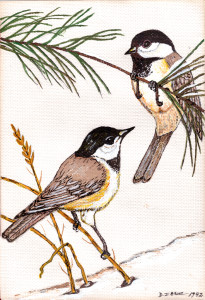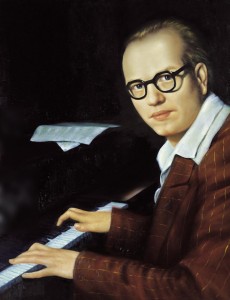Though Olivier Messiaen is often considered to be one of the most influential and celebrated composers of the twentieth century, for many people he is someone yet to be discovered. What do we know about Olivier Messiaen? He was a religious man, deeply attached to his Catholic faith. His work was prolific and meticulous throughout a long career, but he wrote almost no music specifically for liturgical settings. He drew inspiration from diverse sources such as Japanese music, birdsong, and Indonesian percussive instruments. He often stated that colour was important to his compositional process – and in fact he perceived colours when he heard certain musical chords, a neurological condition known as synaesthesia. Though hardly a household name, he is decidedly an intriguing figure.
Messiaen’s innovative techniques and compositional ideas have been widely studied by academic musicians. His works often pose questions about the relationship between music and spirituality, and his representation of religious subjects, such as the Incarnation, has caused debate and controversy. Messiaen’s use of musical language and rhythm to evoke mysteries that are beyond the dimension of time has left us a body of work that is helpful to spiritual seekers keen to meditate on his theological explorations. These are often reflected in the titles of his compositions, such as Visions of the Amen, Twenty Gazes on the Christ-Child and Meditations on the Mystery of the Holy Trinity. Although his music can be challenging, it offers delight, humour and wonder.
Messiaen was born on December 10, 1908 in Avignon, France, his mother a poet and his father a teacher and Shakespearian scholar. During the First World War he lived with his mother and grandmother in Grenoble where he encountered the landscape and natural setting that were to become great influences on his life and music. Here he taught himself to play the piano and in 1917, at the age of nine, he wrote his first composition. After the war, the reunited family settled in Nantes where he continued to be influenced by the natural world, theatre, literature and, at the root of it all, his Catholic faith. When he was ten years old his harmony teacher introduced him to Claude Debussy’s music for the ballet Pelleas et Mélisande and this helped set his early musical direction. He went on to study at the Paris Conservatoire from 1919 until 1930 and in 1931, at the age of 22, he was appointed organist of the parish church of Sainte Trinité in Paris. He subsequently held that appointment for over 60 years.
For the first year of World War II, Messiaen served as a medical auxiliary with the French military. He was captured in May 1940 and imprisoned in the Nazi prison camp Stalag VIII-A. Here he composed what is perhaps his best-known work, Quartet for the End of Time, first performed by Messiaen and a few fellow prisoners on January 15, 1941 in the prison camp, before an audience of guards and other prisoners. Based on Chapter 10, verses 1 to 6 of The Book of Revelation, it is the first of Messiaen’s works to incorporate birdsong and despite the dire situation of the imprisoned composer and musicians, the work is full of hope.
His last major work was an epic opera, Saint Francois, the story of Saint Francis of Assisi, another simple man who loved music and nature. Messiaen said shortly before his death, “Certain people are annoyed that I believe in God but I want people to know that God is present in everything, in the concert hall, in the ocean, on a mountain, even on the Underground.”
Alex Ross says in his book The Rest is Noise: Listening to the Twentieth Century that Messiaen led a dull life, as “saints are rarely as interesting as devils”. Messiaen seems to have been respectful to all, kind and generous. His students at the Paris Conservatoire, where he taught for over 35 years, described him as an outstanding teacher. He experienced God as both immensely complex and infinitely simple, reachable and everywhere. Messiaen’s sense of joy is especially present in his music pieces that are based on birdsong. As a life-long birdwatcher, Messiaen transcribed birdsong wherever he went. He felt that their songs often recalled the inflections of Gregorian chant, which he believed to be the purest of all music and the only truly fitting accompaniment to the liturgy. He died in Paris on April 27, 1992 at the age of 84.
With seventy published compositions to his name, Messiaen’s intrinsic spirituality seems to always underlie his musical language, though not all of his works have explicitly religious themes and symbols. Calgary and area residents will have a rare opportunity to hear Messiaen’s grand and joyful Turangalila-Symphonie when the Calgary Philharmonic Orchestra perform the piece at the Jack Singer Concert Hall on November 29. Turanga refers to ‘tempo’ and lila to ‘life-force, the game of creation, rhythm and movement’, so the concert should be an exuberant experience. This orchestral work features an early electronic instrument called an ‘Ondes Martenot’. Originally designed to be similar in sound to the theremin, it was first heard at the Paris Opera in 1928.
Olivier Messiaen was a remarkable and faith-filled man who deserves to be better known and appreciated.
Olivier Messiaen improvising at the organ, in the Church of Sainte Trinité:
Delightful archival footage from Messiaen’s Conservatoire music analysis class:










